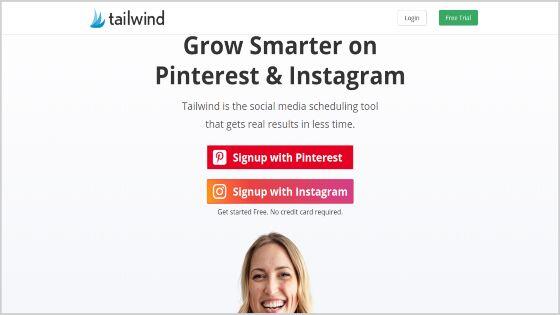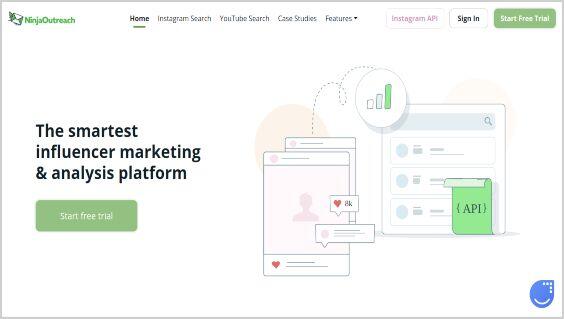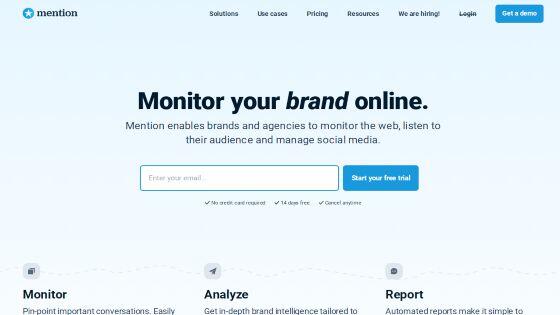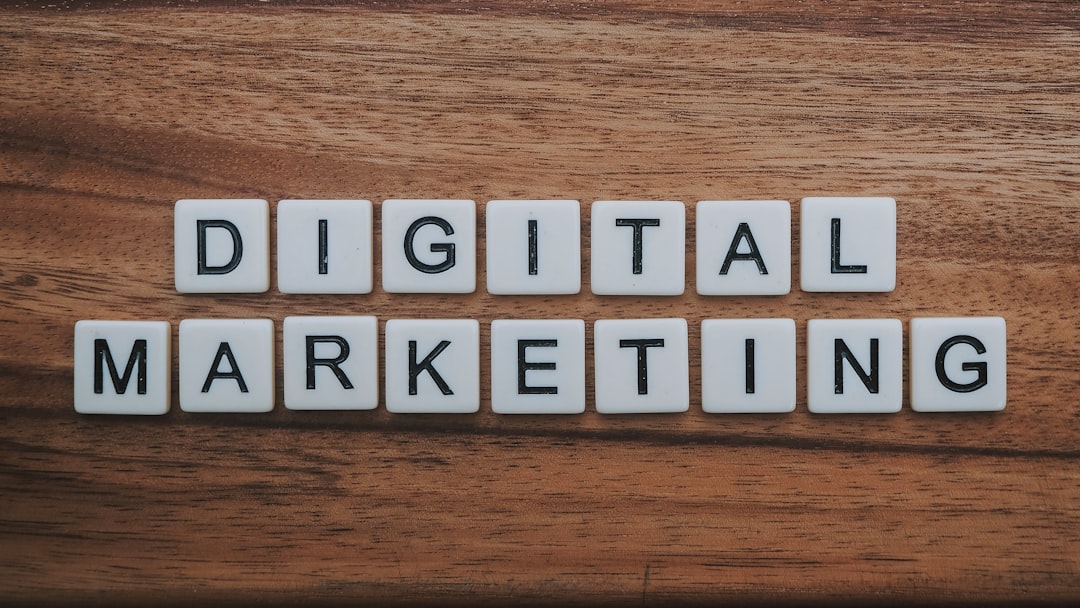 Photo by Diggity Marketing
Photo by Diggity Marketing
Originally Posted On: https://stevenjwilson.com/brand-awareness-digital-marketing/
When you are buying toys, do you look for plastic blocks or Legos? When you are shopping for office supplies, do you search for sticky paper or Post-It Notes?
These brands have successfully embedded their product names in their respective industries. They have become so well-known that people would mention these brands’ names rather than their generic terms (Kleenex vs. tissue, Coke vs. cola, Band-Aid vs. bandage, and so on).
And that’s the magic of brand awareness.
In this guide, we will discuss the importance of brand awareness for your business. Find out why you should prioritize brand awareness in your digital marketing goals, and discover what strategies you can do to establish your brand among your audience.
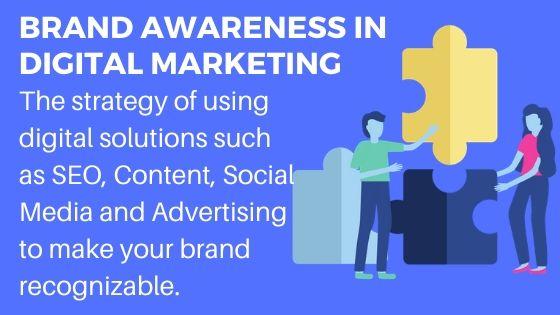
What Is Brand Awareness in Digital Marketing?
Brand awareness is a term that refers to the degree of consumer familiarity of a product by its name. It distinguishes the product of a brand from its competition.
Simply put, it is a measure of how well your target audience recognizes your brand.
And what does a high level of brand awareness mean for your business?
More sales.
When consumers are confronted with choices, they are more likely to buy a product from a brand they are most familiar with. That’s why brand awareness should be a priority for businesses, especially startup brands.
In fact, brand awareness is so crucial that 37% of marketers say it was their top priority in 2019.
Now that you get how vital brand awareness is to you, the next question is: “How can you establish brand awareness?”
One way to do this is through digital marketing.
How Digital Marketing Can Increase Brand Awareness
Over the years, digital marketing has become a gamechanger for many brands. It is continuously dominating the marketing world, with over half of the world’s population using the Internet.
With digital marketing, you can:
- Reach a more targeted audience in a more cost-effective and measurable way
- Level the playing field, especially if you’re a small business
- Interact with prospects and learn valuable insights from them
- Be hyper-personalized with your audience
- Reach a global marketplace
Online is where your customers are. And digital marketing is beneficial to reach them, hence establishing awareness around your brand.
To get started with digital marketing, here are some strategies you can do to increase consumer familiarity with your product.
Digital Strategies to Increase Brand Awareness
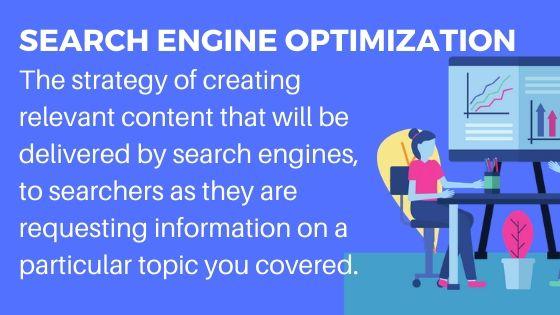
Search Engine Optimization
You want your brand to be found online and beat the competition. And this is what search engine optimization (SEO) can accomplish for you.
SEO helps show your product in front of your customers. This strategy allows your webpage to appear on the first page of search results, such as Google.
The primary role of SEO is to gain websites ‘unpaid’ organic traffic from the search engine results page (SERPs). This is done through various on-page and off-page methods.
How SEO Impacts Brand Awareness
With increased traffic to your website, your brand gets exposed to a broader audience.
And more exposure means more people recognize what your brand does.
For instance, one case study illustrates how digital marketing consultant Hunter Branch saw firsthand what SEO could do to improve brand awareness.
Brand Awareness Example Using SEO
In the said study, Branch shared working with one client, a writing coach, who was generating about 20,000 visitors monthly from search.
The client is already a successful author prior to putting up his online presence.
After implementing a full-blown SEO strategy, the client, who just transitioned to becoming an online writing coach, started to gain an average of 140,000 organic visitors per month.
But here’s the best part: The client is now widely known as one of the top writing coaches online. That’s how appearing in the top 3 organic search results made an impact on his branding.
How to Boost Brand Awareness with SEO
As of this year, more than 64% of marketers are actively investing in SEO. You should want to keep up with the competition, here are some ways to use SEO for brand awareness.
Link building
The more high-quality links that refer to your page, the higher you rank in the SERPs. But how do you get those links?
I believe that high-quality content is equal to high-quality backlinks.
By high-quality content, I mean unique, relevant, and valuable content made for users & for search engines. Some examples include how-to guides and free downloadable templates.
Aside from creating high-quality content, you can also build backlinks through email outreach, guest posting, and public relations, among others.
Optimizing content
Creating high-quality content is one thing; optimizing content is another.
For search engines like Google to find your content, you have to add keywords to your page to increase organic visibility.
Since you’re specifically targeting audiences at the awareness stage, it is also essential to optimize your content for non-commercial keywords.
Another key is to put more focus on long-tail keywords. This type of keywords has a 3% to 5% higher click rate than generic searches.
Also, aligning your keyword strategy with your branding helps you assert more control over the perception of your brand. That’s why it is crucial to choose keywords that are relevant to your brand.
Internal Linking
When a prospect landed on your page, help him navigate around your website through internal linking.
Internal linking involves adding a link to another page on your site using anchor text. Anchor text can be your main keywords, a variation of your main keywords, or secondary long-tail keywords.
With a clear strategy, you can improve the user experience while driving traffics to your pages.
But internal linking does not only direct visitors to your other pages. It also passes link equity to improve your SERPs ranking.
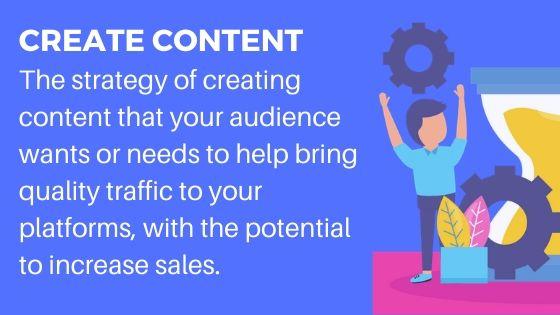
Content Creation
In the previous strategy, we have briefly touched the importance of content. However, since content creation is so vital in building brand awareness, it warrants further discussion as our next digital strategy.
For this guide, we’ll focus on the creation of branded content and how it impacts brand awareness.
But what is branded content?
Branded content is content that brings value to your customers. It lets you show to your audience who your company is and what your brand represents.
This type of content strays from traditional advertising. Its purpose is to entertain or to inform, to catch consumer’s attention, and drive real engagement.
This includes articles, videos, infographics, and podcasts, among others.
How Content Creation Impacts Brand Awareness
Brand awareness is more than just consumers knowing the name of your business. It shows how well your audience understands the qualities that make your company unique.
It is through developing an effective content strategy that sets your brand apart from the competition.
Content is also a way to show personality, share opinions, and to position your brand on issues. Simply put, content is what humanizes your brand.
And consumers would likely do business with humans over a mere brand.
Brand Awareness Example Using Content Creation
One great example of a successful branded content is Dove’s Real Beauty Sketches campaign.
The campaign started with customer research suggesting that only 4% of women would describe themselves as “beautiful.”
From the said research, Dove came up with a short video highlighting how women perceive themselves versus how strangers describe them.
The video garnered over 114 million views in just one month, and it became the most-watched branded content in 2013, even with some intense criticisms of the ad.
With the campaign’s success, Dove got the world talking. And the best part? Dove was able to send their brand message that “beauty is for everyone,” separating them from their competitors.
How to Boost Brand Awareness with Content
According to B2B Content Marketing, seventy-two percent of marketers believe having a good content strategy was a significant key to their success. Do you implement a content strategy for your brand already?
If not, here are some ways to get you started.
Understand your audience
Who is your audience? Where do they spend their time online? What are their likes, preferences, and interests? What are their problems that needed solutions?
You are connecting with your audience, so naturally, you will begin to understand them. And when you have a good understanding of your audience, you can tailor your content to make it speak to them.
Create your brand story
Aside from your audience, you should also understand your brand.
What is your story? What are your visions? What are your company’s values? What is your company’s voice? What solution do you offer to your audience?
To craft an effective content strategy, you must know these crucial things about your business because these are the reasons why your customers would care about your brand.
Choose your channels
Which type of content do you want to use for your brand? For the awareness stage, you’ve got plenty to choose from.
Blog posts and articles are the most common forms of content for the early stage in the marketing funnel. If you’re looking for content ideas, this is where your understanding of your audience would come in handy.
If you’re targeting an audience with a short attention span, infographics are a perfect choice. This is because this type of content is easy to read and understand.
Meanwhile, videos are a great avenue to show the personalities of your brand. Statistics also show that video is the number one form of media used in content strategy, overtaking the first two forms of content mentioned above.
Test your content strategy
Now that you have determined vital elements of a good content strategy, it’s time to put them together and create your content.
Monitor how your content performs, analyze its effectiveness through key metrics, and adjust as needed.
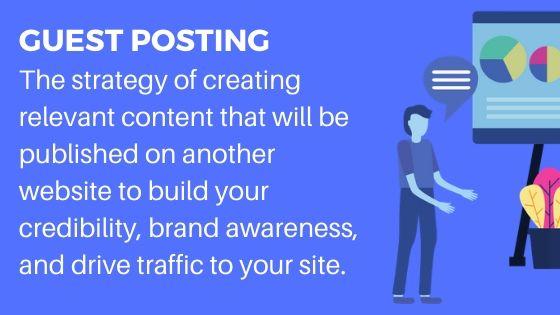
Guest Posting
Guest posting is one of the fastest ways to boost awareness about your brand. In this strategy, you find popular blogs relevant to your niche, and then you write a high-quality article for them.
How Guest Posting Impacts Brand Awareness
Writing for popular blogs shows you’re active in the community. It helps you display your expertise in your industry.
And what happens when you display your expertise in front of a large audience? You establish your reputation in your niche.
The great part? Popular blogs have a huge targeted following, and you’re able to catch their attention with a high-quality post.
That’s how crucial guest posting is in improving brand awareness.
Brand Awareness Example Using Guest Posting
An excellent example of guest posting success is Bryan Harris’ story.
With a single guest post at Okdork on “how to get your first 100 email subscribers,” he was able to get 1,782 visitors on the first two days the article was published.
Of that total figure, 73% of them were new visitors. Prior to the guest post, his blog was garnering 285 monthly visitors on average.
What’s even more significant is that 215 new people opted into his email list. That’s a 12% overall conversion rate.
His first guest post has helped Bryan kickstart his blog, which now has a loyal audience.
How to Boost Brand Awareness with Guest Posting
Guest posting promises excellent results, but it is easier said than done. So, here are a few tips to increase your chances of succeeding with this strategy.
Find a popular blog that is relevant to your industry
A good candidate for a blog to guest post has high reader engagement. Look for comments, shares, and purchases, which are a good indicator that you’ll benefit from guest posting on that blog.
Research the blog and its audience
Before you pitch a topic, be sure to research the blog’s style and topics that it covers. Also, know its readers’ interests, preferences, and problems.
Create high-quality content
When we say high-quality, we mean in-depth content that is worthwhile to your future readers. Bryan learned from his first guest post that valuable content takes time, advising to spend more than 20 hours writing.
Respond to comments
When you guest post, you have to keep readers engaged. Responding to every comment is crucial if you want to build your brand.
Be consistent
Significant results from this digital strategy take time to develop. If you are going to implement this strategy, be sure to commit to guest posting consistently.
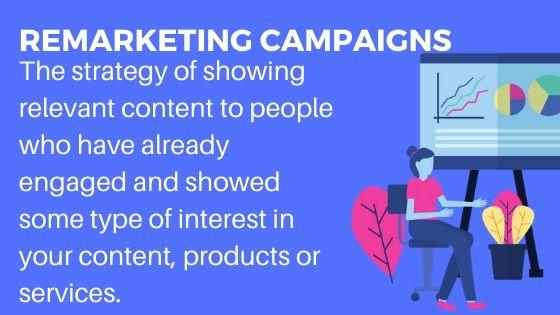
Remarketing Campaigns
Remarketing is a type of online advertising that allows you to show targeted ads to people who have already visited your website.
This ad follows visitors across the Internet. They appear as they browse the web, watch YouTube videos, and scroll through their social media feeds.
How Remarketing Impacts Brand Awareness
Remarketing allows you to remain connected with your audience. Once people visit your website, ads will follow them all over the web.
This gives your brand great exposure. And more exposure means your brand becomes more recognizable, giving you a competitive advantage.
But aside from brand awareness, remarketing campaigns also increases the chance for your visitors taking action. This is especially crucial since 70% to 96% of websites visitors leave without taking action and will never return, according to Bounce Exchange.
Brand Awareness Example Using Remarketing
Software company Lumension achieved an 865% increase in homepage views thanks to its remarketing efforts. This is despite cutting its marketing budget by 30%.
How did they do it?
The company retargeted five main groups, combining this technique with their awareness efforts.
Its awareness campaign has increased the audience size for their retargeting campaign. Its retargeting, on the other hand, converted the new visitors they gained from their awareness campaign.
And what was Lumension’s biggest takeaway? Be willing to take a risk. The company’s success sprouted from its openness to play with a strategy they were unfamiliar with.
How to Boost Brand Awareness with Remarketing
If you want to find success in this strategy, it pays to know the different types of remarketing campaigns you can implement for your brand.
Display Ads
Display Ads show up to people who have visited your website.
This form of remarketing can appear in two main types of platforms: Google display network and social media.
Both platforms offer large viewership that can help raise awareness about your brand.
Email remarketing
This type of remarketing campaign targets people who open or take some specific action on your emails.
People who open your emails already showed their interest in your brand. With email remarketing, you can reinforce this interest by keeping your brand on their minds by delivering the most relevant content to their interest.
Remarketing search ads
This campaign allows you to display remarketing ads on the search engine themselves. This will enable you to target people who have visited your website.
Video remarketing
People who have either visited your website or watched your videos get retargeted with this method. This type of ad appears on YouTube and the Google display network.
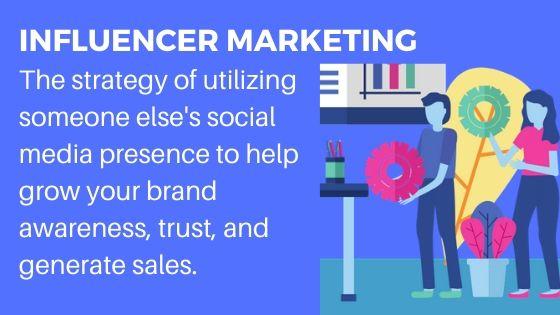
Influencer Marketing
Influencer marketing involves using someone else’s social media presence to help your brand. Its primary function is to build brand awareness as you build trust and credibility among your audience.
Eventually, it helps generate more sales for your business.
How Influencer Marketing Impacts Brand Awareness
Fact: driving brand familiarity is four times more effective when you collaborate with YouTube influencers than those with celebrities.
Just like in guest blogging, influencers offer a huge following. And what does that mean for your brand?
You can tap into an influencer’s followers, broadening your brand’s reach.
Teaming up with influencers relevant to your industry also establishes trust and credibility to your brand, which are essential elements in building brand awareness.
Brand Awareness Example Using Influencer Marketing
One good example of influencer marketing is Gillette’s Instagram-focused strategy in 2019.
Gillette worked with a diverse roster of influencers to resonate with Millennial consumers. The brand leveraged gay influencers in addition to their usual roster of athletes and parents.
The primary theme of the campaign was gift-giving. Their influencers make reference to Gillette products as an appropriate gift for family members for the holiday season.
How to Boost Brand Awareness with Influencer Marketing
Influencer marketing is one of the fastest ways to raise awareness about your brand. In one survey, 89% of marketers said ROI from this strategy was comparable to or better than other networks.
To take advantage of this digital strategy, here are some ways you can use influencer marketing for your brand.
Giveaways
Asking an influencer to promote giveaways or competition can significantly boost engagement.
Brand mentions
A single mention of your brand by an influencer can reach far and wide.
Free products
Request influencers to promote your brand in exchange for free products or services. This is a popular alternative to paid influencer promotion.
Ambassador programs
Making an influencer the face of your brand can increase the trust and credibility of your products.
Takeovers
Allowing an influencer to post on your social accounts for some time helps you gain more followers and engagement.
Events
Invite influencers to cover events for a significant boost in brand awareness. This is also a great way to foster influencer relationships through networking.
Challenge your influencer
Let influencers compete among themselves, involving the use of your product. Base the winning criteria on social shares or traffic generated to your website to boost brand visibility and engagement significantly.
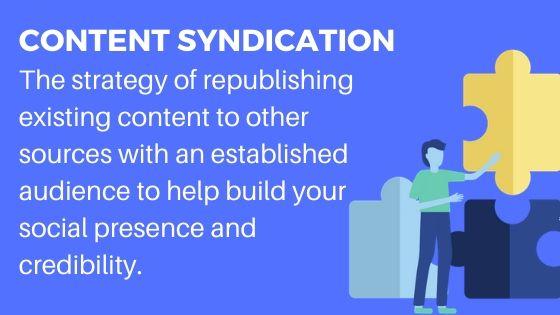
Content Syndication
Brand awareness is also brand recognition. Brand recognition is the extent of how the public can identify your brand by its attributes.
For people to recognize your brand, it’s not enough that you publish content and just leave it there hopes and wishes.
You have to make the content appear elsewhere for more exposure. This technique is otherwise known as content syndication.
How Content Syndication Impacts Brand Awareness
Content syndication is a technique involving republishing content on other sites to get a wider audience.
Syndicated content is a great way to increase brand awareness as well as drive links to your website. This is especially true if you get featured in most of the biggest and most influential sites on the Internet.
You may have heard that duplicate content from syndication can hurt your SEO and potentially penalize your website. Technically this is true but not something I’d stress about as long as you complete these three things.
- Use Googe Search Console to make sure your content is indexed and recognized by Google before syndication.
- Share your content across your branded social media accounts and profiles.
- Add the rel canonical tag to tell search engines that your page URL is the master copy that you want to appear in SERPs.
Brand Awareness Example Using Content Syndication
BestSelf Co is known in its industry for its productivity articles. To put that in numbers, they get 186,000 new visitors every single month.
But how did they do that? By combining fantastic content marketing and blog posts with content syndication.
They targeted big sites like Inc to turn its visitors into BestSelf blog readers.
And they did successfully, driving over 1,800 email signups to their newsletter after a few weeks.
They now leverage the new traffic from syndicated content into over $2 million in revenue.
How to Boost Brand Awareness with Content Syndication
Since it is hard to land syndicated content on publishing giants like CNN, BBC, and the New York Times, you can start small through self-service syndication.
In self-service syndication, you republish your content on publishing websites such as the ones below:
Social networks
Social platforms such as LinkedIn and Quora feature their built-in publishing tools. LinkedIn publishing is mainly a great avenue as it notifies your connections every time you post an article.
Blogging platforms
You may also consider republishing on other blogging platforms aside from your own. Examples of this are Medium and Tumblr.
Medium is an excellent choice for self-service syndication because of its handy import tool that lets you import your content from anywhere on the web. It also has its own loyal followings, enabling you to reach a new audience and engage with them.
Multi-author blogs
Multi-author blogs like Business 2 Community and Social Media Today, amongst many others, also provide a syndication-friendly platform for business-related content and digital marketing content, respectively.
Brand Awareness Tools
Brand awareness would be nearly impossible to pull off without the help of appropriate tools.
If you are looking for tools to boost your brand awareness, here are some of our favorite resources that we recommend for you:
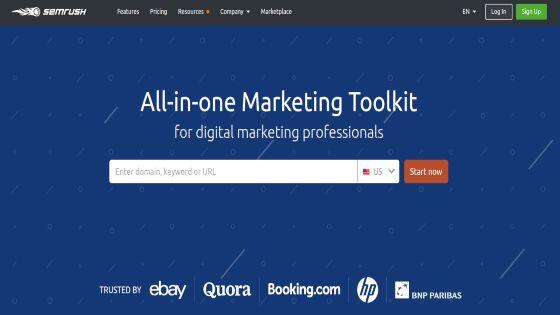
SEMush
SEMRush is an online visibility management platform that helps you find profitable keywords. It also provides valuable insights to better position brands in search engine rankings and the minds of their audience.
Highlighted Features
- Brand Monitoring
- Keyword Research
- Traffic Analysis
- Market Explorer
- Organic Research
- Advertising Research
- Display Advertising Tool
- Content Analyzer
- Domain vs. Domain
- Position Tracking
Price Range
16% annual discount $83.28-$333.28/month. Month to month option available.
Tailwind
Tailwind is a social media scheduling tool for automating calendar and maximizing reach. This tool helps you create a posting schedule based on audience engagement, traffic, virality, and more.
Highlighted Features
- Analytics Reporting (Pinterest, Instagram)
- Content Marketing (Pinterest)
- Content Optimization (Pinterest)
- Content Promotion (Pinterest)
- Content Recommendations (Pinterest)
- Scheduling (Pinterest, Instagram)
- Monitoring & Trends (Pinterest)
- Hashtag Monitoring (Instagram)
- Content Management (Instagram)
- Listening (Instagram)
Price Range
Free trial and save $60 with an annual discount of $9/month per account. Month to month option available.
NinjaOutreach
NinjaOutreach is an influencer marketing platform that helps you find the right influencer to attract your target audience. This tool lets you filter through millions of influencer insights from its massive database.
Highlighted Features
- Find Influencers (Instagram, Twitter)
- Link Building
- Contact Relationship Management
- Business Lead Generation
- Blogger Outreach Tool
Price Range
Free trial with an Annual 60% discount of $49-149/month. Month to month option available.
Learn More About Ninja Outreach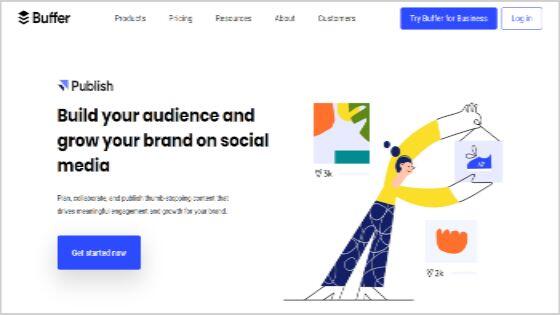
Buffer
Buffer is a social media management platform that allows you to publish content, analyze campaigns, and engage your audience with a single tool. It makes sharing your story and building your brand on social media easier.
Highlighted Features
- Analytics and insights
- Profile management
- Customized scheduling
- Multiple posts and tweets
- RSS feeds connectivity
- Social profile sharing
- Stats comparison
- Agency/business planning
- Multi-media format sharing
Price Range
14 Day Free trial. Limited Free plan available after trial. 20% discount with an annual plan of $12-$85/month. Month to month option available.
Mention
Mention is an all-in-one tool for monitoring the web, listening to your audience, and managing your social media. This social listening tool allows you to monitor what people say about you online.
Highlighted Features
- Analytics
- Automated Publishing
- Content Management
- Customer Engagement
- Social Media Monitoring
- Brand Tracking
- Audience Segmentation
- Influencer Tracking
- Reputation Management
- Trend Tracking
Price Range
Limited Free plan. 2 months Free with annual plan $25-$450+/month. Month to month option available.
Wrapping It Up
Brand awareness is the first step to creating a business that converts.
But creating awareness about your brand doesn’t happen overnight. It takes a carefully crafted strategy to find success.
If done right, the techniques above, combined with some great tools, can help you build familiarity around your brand and lead to increase growth and revenue.
